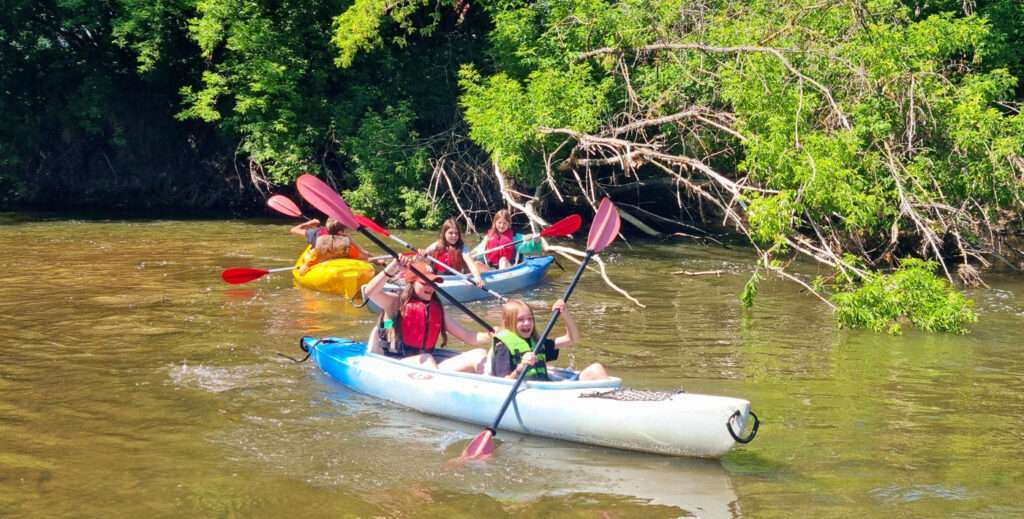Have you ever seen instructors and competitors maneuver their boat with precision, efficiency, and grace – all the while expending seemingly little effort? At the heart of their technique are some basic concepts that can lead to more efficient and safer paddling. This doesn’t mean all great paddlers paddle alike. It does mean that efficient paddlers share some common practices and are aware of important ideas related to how boat, paddle and paddler come together to create precise boat movement with minimum effort. Here are some of those essential concepts:
Move the Boat to the Paddle
To make the canoe move, reach out in the direction you want it to go, plant the paddle (think of it as landing in quick-drying cement) and move the boat (or better, your body) toward the paddle. If you move the paddle to the boat, the paddle moves, the boat doesn’t. While seemingly simple, this way of thinking about strokes is critical to efficiency.
Use both Dynamic and Static Strokes
Strokes can be dynamic, where the boat is pulled toward or pushed away from the paddle placement; or they can be static, when the paddle is planted and held firmly in place while the boat moves. Static strokes help you use momentum already gained from dynamic strokes and/or the current.
Rotate Your Torso
Rotate your torso for more powerful, effective strokes. The large torso muscles are an efficient source of power. Rotate by twisting at the waist. Lower body rotation can also be an effective way to enhance control and comfort.
Make Power Strokes Parallel
Forward and reverse power strokes should be executed as parallel to the centerline of the canoe as possible.
Move Away from the Pivot Point
Turning strokes, such as sweeps, stern draws and cross-bow draws, should be executed as far from the pivot point as is practical. Choke up on the paddle (move your shaft hand toward your grip hand) to get the blade farther from the pivot point.
Start with a Good Grip
Hold the paddle with hands slightly wider than shoulder width apart. Avoid holding the paddle at the throat.
Protect Your Shoulders
Avoid shoulder dislocations and shoulder soreness by keeping your arms and hands in front of the shoulder plane. Use torso and lower body rotation to help keep shoulders safe. For reverse strokes, turn your shoulders and hips toward the side of the boat. Transverse kneeling makes it hard to get your hands behind the shoulder plane, providing a safe and effective paddling position. Torso and lower body rotation equals shoulder safety.
Your mother was right – use good posture Keep your upper body erect for comfort, visibility and bio-kinetic advantage.
Get Vertical
For most strokes, keep the blade vertical to avoid pushing water down or lifting water. Extending arms (having almost straight elbows) and pushing the control hand and grip out over the water will help maintain a vertical blade.
Control Blade Angle
Use efficient blade angle (pitch) to maximize efficiency and control. Remember: the orientation of the paddle grip reflects blade angle. If the grip is perpendicular to the canoe’s centerline, so is the blade. If the control thumb (the thumb on the grip hand) is extended to point away from the shaft hand shoulder (as in a cross turning high brace), the blade orientation will be open approximately 45 degrees in relation to the centerline. Grip angle is parallel to blade angle.
Stay on the Level
In most modern solo canoes designed for quietwater, keep the canoe level to travel straight . Some whitewater designs may track better when heeled to take advantage of a sharp, angular chine.
Heel to Turn
In most modern solo canoes, heel the canoe to increase rocker and facilitate turning. Paddlers soloing a large tandem canoe may have to kneel in the onside chine and maintain a heel to achieve an appropriate and efficient paddle position.
On Your Knees, Please
Use a variety of kneeling positions to shift body weight forward, aft and/or from side to side in the canoe for enhanced performance, maneuvering and safety. Weight shifts can help the boat do most of the work (photo 14), and using a variety of muscle groups by altering your position can decrease fatigue and injury to one area.

